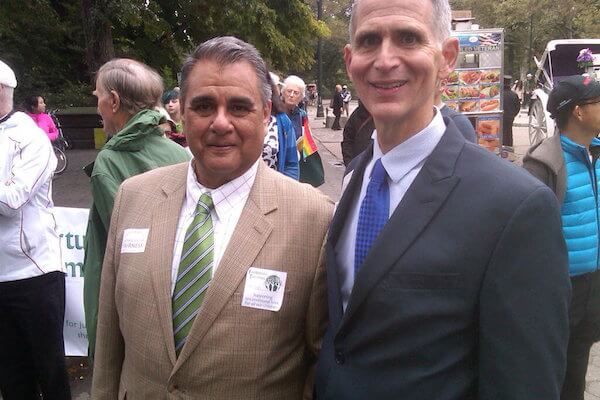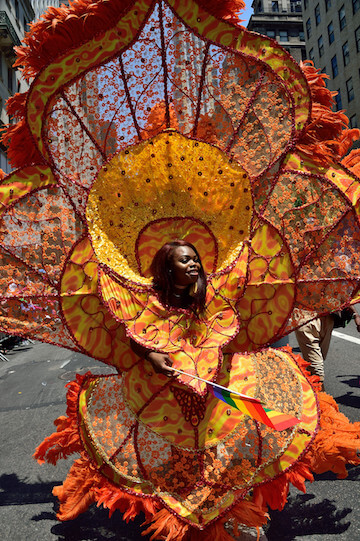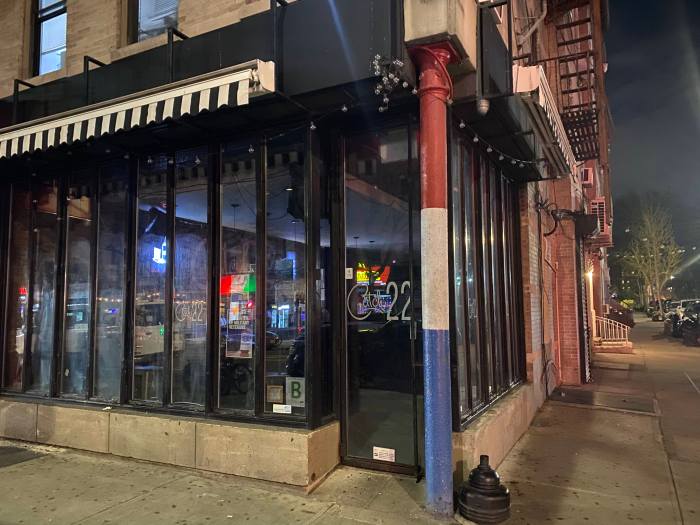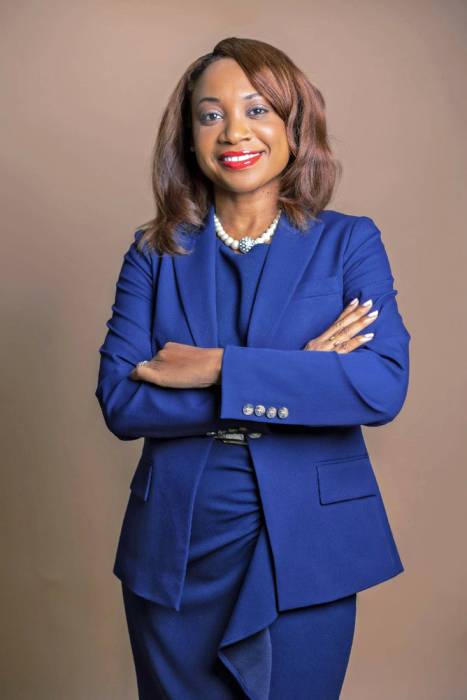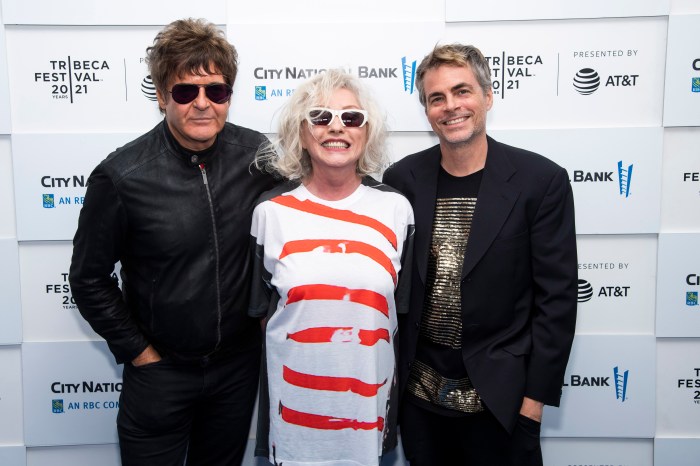Cardinal Jorge Bergoglio, now Pope Francis I, holding the Baby Jesus during Midnight Mass on Christmas Eve 2010. | MICHAEL LUONGO
During my years of covering Buenos Aires and living there, I have photographed an equal number of Christmas Eve Midnight Masses held at Catedral Metropolitana, the city’s main Catholic church, and Gay Pride marches, which step off from in front of the same building.
One of those events has stagnated, with fewer Argentines in attendance, little media coverage, and almost no foreigners on hand. The other has blossomed from a tense, nearly clandestine gathering into one that attracts tens of thousands of locals and is a major draw for tourists. Year by year, it has become an increasing part of the national conversation, influencing lawmakers and even the president.
It is the former — Midnight Mass — that has lost its salience in Argentine culture. Gay Pride, in contrast, has grown in visibility and influence. These shifts occurred under the watch of Cardinal Jorge Bergoglio, who served as the archbishop of Buenos Aires and was the nation’s most powerful prelate prior to his recent elevation to the papacy as Francis I.
Many have voiced the hope that Pope Francis will revive the Catholic Church throughout the world, helping it to move beyond the sexual abuse scandals that have dogged it over the past decade and more. Yet if Bergoglio’s time in Argentina is any indication, he will continue to lead the Church into irrelevance, especially on LGBT issues.
Cardinal Bergoglio called marriage equality “a machination of the Father of Lies,” but the country’s political leaders refused to listen.
My first time photographing Gay Pride was in 2004. As the crowds gathered, hundreds of young men hostile to the marchers stood in front of Catedral Metropolitana. One explained to me he was a “protector of the church” and pointed to red paint splatters that vandals had thrown onto its façade. The only attacks I witnessed, however, were those that these “protectors” waged against the parade crowd. The young men outnumbered the LGBT marchers in front of the church, with most of the Pride crowd waiting for the parade to begin on Plaza de Mayo, the city’s ancient colonial square which the church overlooks. Only after dark did marchers make their way onto Avenida de Mayo, the city’s most important processional route, with the crowd heading toward the Congreso building where a political rally was held.
Marriage equality activists José Maria Di Bello and Alex Freyre in front of Buenos Aires’ Catedral Metropolitana during Gay Pride in November 2010. | MICHAEL LUONGO
I last covered the parade in 2010, by which time it was an official city cultural event. The rally was no longer a protest against Congreso, but instead took place on its steps, welcomed by the national government. Gay Argentines lined up by the thousands in front of the cathedral, no longer afraid of the television crews that covered the event.
Each time I photographed Midnight Mass, the church appeared full, but media and tourists were nowhere to be seen. The streets surrounding the cathedral were desolate, the majority of city residents instead at parties or at home with family. Argentine friends never understand my interest in Midnight Mass, known locally as Noche Buena.
I was in Buenos Aires the day Francis was elected by his fellow cardinals and my immediate reaction was to head to the cathedral, assuming thousands would turn out. My taxi driver complained we would encounter blocked-off streets and mobs descending on the church to pray for the pope of the Pampas. But we found little traffic and far more journalists than worshippers. In fact, pedestrians on their way to the subway used the cathedral’s steps to avoid the media maze, while police lined its walls as if worried there might be backlash against the choice of a religious conservative as the new pope. The Mass taking place was no more crowded than usual.
To be sure, the crowds outside the cathedral grew as the days passed, but the lack of a spontaneous outpouring in the hours after Francis’ selection surprised me and is significant.
Revelers outside the cathedral on Gay Pride day in 2010. | MICHAEL LUONGO
As Argentina’s same-sex marriage law was debated in 2010, Cardinal Bergoglio called the idea “a machination of the Father of Lies.” The country’s political leaders refused to listen. At that year’s Gay Pride, there were virtually no protectors in front of the cathedral. As had the legislators, most of Buenos Aires simply ignored the Church. The cathedral became a photographic backdrop for drag queens and muscle men, who posed for television crews often arm in arm with politicians and burly union leaders.
The day Bergoglio was elected pope, red paint splatters were still visible on the walls of the church, the anger many Argentines feel toward the Catholic Church literally written on the façade of the city’s main cathedral. In a majority Catholic country, if the Church is behind the times socially, it becomes not just irrelevant but also an object of hatred among many people. The disconnect between the Church and the people of Argentina is something Bergoglio did little to cure. He himself must take the blame.
The selection of a pope from Latin America is significant, and he has the opportunity to bring the sensitivity to the poor he showed in Buenos Aires to the Holy See. But that won’t change what millions of Argentines think about his socials views, especially his contempt for gay men.
Argentina remains a nation where church and state have no official separation. Only a Catholic may be president, a requirement that forced Muslim-born Carlos Menem to convert prior to his decade in office beginning in 1989. The archbishop of Buenos Aires holds a seat in Congress, a reminder of the Church’s power. Shrines to the Virgin of Luján, the country’s representation of Mary, adorn the Buenos Aires subway system. As in much of the Catholic world, Gay Pride celebrations in Buenos Aires are held on Saturday rather than Sunday, a lingering sign of deference to the Church.
None of this mattered, however, on July 15, 2010, when Argentina became the first Latin American nation to make same-sex marriage the law of the land. This model of progress, ignoring the Church’s vitriolic assault on LGBT citizens, is spreading across the Catholic world.
In 2000, amidst the Church’s Jubilee celebrating two millennia since the birth of Christ, the indomitability of LGBT progress was clear. The first World Pride event was being held in Rome at the same time, and Pope John Paul II, a vocal critic of it taking place, was powerless to stop it from crowding his own party.
The Vatican, now in Argentine hands, finds itself even weaker. Bergoglio, with his anti-gay pronouncements even as the LGBT community made historic gains, proved the Church’s growing marginality in the lives of Argentines. As Argentina has done, the world will continue to make progress on LGBT rights. It is the Church that people will leave behind. Will St. Peter’s in Rome under Francis I become a paint-splattered irrelevancy, an obstacle on the way to the subway station as did his Catedral Metropolitana in Buenos Aires?
Only time will tell. People and the world they live in move on, embracing LGBT issues. So must the Church.
Michael Luongo is a freelance journalist and the author of “Frommers Buenos Aires.”






























